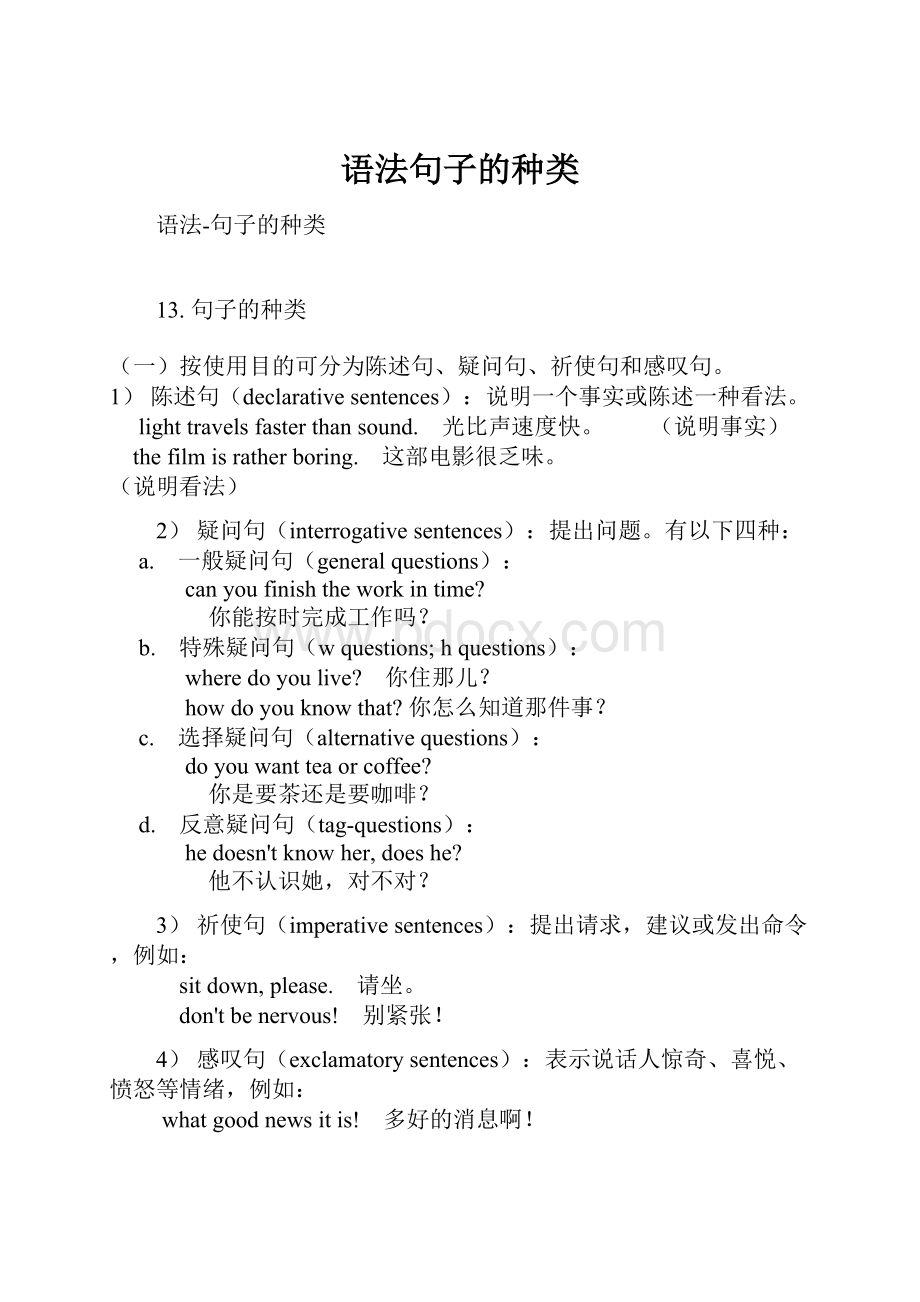语法句子的种类.docx
《语法句子的种类.docx》由会员分享,可在线阅读,更多相关《语法句子的种类.docx(9页珍藏版)》请在冰豆网上搜索。

语法句子的种类
语法-句子的种类
13.句子的种类
(一)按使用目的可分为陈述句、疑问句、祈使句和感叹句。
1)陈述句(declarativesentences):
说明一个事实或陈述一种看法。
lighttravelsfasterthansound. 光比声速度快。
(说明事实)
thefilmisratherboring. 这部电影很乏味。
(说明看法)
2)疑问句(interrogativesentences):
提出问题。
有以下四种:
a. 一般疑问句(generalquestions):
canyoufinishtheworkintime?
你能按时完成工作吗?
b. 特殊疑问句(wquestions;hquestions):
wheredoyoulive?
你住那儿?
howdoyouknowthat?
你怎么知道那件事?
c. 选择疑问句(alternativequestions):
doyouwantteaorcoffee?
你是要茶还是要咖啡?
d. 反意疑问句(tag-questions):
hedoesn'tknowher,doeshe?
他不认识她,对不对?
3)祈使句(imperativesentences):
提出请求,建议或发出命令,例如:
sitdown,please. 请坐。
don'tbenervous!
别紧张!
4)感叹句(exclamatorysentences):
表示说话人惊奇、喜悦、愤怒等情绪,例如:
whatgoodnewsitis!
多好的消息啊!
(二)句子按其结构可以分为以下三类:
1)简单句(simplesentences):
只包含一个主谓结构句子叫简单句,例如:
sheisfondofcollectingstamps. 她喜欢集邮。
(主) (谓)
2)并列句(compoundsentences):
包含两个或两个以上主谓结构的句子叫并列句,句与句之间通常用并列连词或分号来连接,例如:
thefoodwasgood,buthehadlittleappetite.
(主) (谓) (主)(谓)
食物很精美,但他却没什么胃口。
3)复合句(complexsentences):
包含一个主句从句和一个或几个从句的句子叫复合句,从句由从属连词引导,例如:
thefilmhadbegunwhenwegottothecinema.
主句 从句
我们到达电影院的时候,电影已经开演了。
(三)基本句型(basicsentencepatterns):
英语中千变万化的句子归根结底都是由以下五种基本句型组合、扩展、变化而来的:
1)主+动(sv)例如:
iwork. 我工作。
2)主+动+表(svp)例如:
johnisbusy. 约翰忙。
3)主+动+宾(svo)例如:
shestudiesenglish. 她学英语。
4)主+动+宾+补(svoc)例如:
timewouldprovemeright.时间会证明我是对的。
5)主+动+间宾+直宾(svoiod)例如:
mymothermademeanewdress. 我母亲给我做了一件新衣裳。
13.1祈使句结构
祈使句用以表达命令,要求,请求,劝告等。
1)祈使句有两种类型,一种是以动词原形开头,在动词原形之前加do(但只限于省略第二人称主语的句子)。
takethisseat.
dobecareful.
否定结构:
don'tmove.
don'tbelate.
2)第二种祈使句以let开头。
let的反意疑问句
a.let's包括说话者
let'shaveanothertry,shallwe/shan'twe?
=shallwehaveanothertry?
b. letus不包括说话者
letushaveanothertry,willyou/won'tyou?
=willyoupleaseletushaveanothertry?
否定结构:
let'snottalkofthatmatter.
letusnottalkofthatmatter.
13.2感叹句结构
感叹句通常有what,how引导,表示赞美、惊叹、喜悦、等感情。
what修饰名词,how修饰形容词,副词或动词,感叹句结构主要有以下几种:
掌握它的搭配,即掌握了感叹句的重点。
how+形容词+a+名词+ 陈述语序
how+形容词或副词+ 陈述语序
what+名词+ 陈述语序
what+a+形容词+名词+ 陈述语序
what+形容词+复数名词+ 陈述语序
what+形容词+不可数名词+ 陈述语序
howcleveraboyheis!
howlovelythebabyis!
whatnoisetheyaremaking!
whatacleverboyheis!
whatwonderfulideas(wehave)!
whatcoldweatheritis!
感叹句的省略形式为:
whatacleverboy(heis)!
典型例题
1)___foodyou'vecooked!
a.howanice b.whatanice c.hownice d.whatnice
答案d.由于how修饰形容词,副词;what修饰名词。
且food为不可数名词,因此a,b排除。
chow+adj.后面不能再加名词,因此只有d正确,其句型为what+adj.+n.(不可数)
2)___terribleweatherwe'vebeenhavingthesedays!
a.what b.whata c.how d.howa
答案a.weather为不可数名词,b,d排除。
c为how+adj.后面不应有名词。
只有a,符合句型what+形容词+不可数名词。
3)---_____ihad!
---youreallysufferedalot.
a.whatatime b.whattime c.howatime d.howtime
答案a. 感叹句分两类:
1:
what+n.+主谓部分
2:
how+adj./adv./v.+主谓部分。
本题属第一种,但省略了bad,相对于whatabadtimeihad!
这是个习惯用语。
13.3强调句结构
常考的强调句结构是it引导的句子。
itis(was)被强调部分+that(who)+句子其他部分。
此结构强调的成分仅限于主语,宾语和状语。
itisfromthesunthatwegetlightandheat.
itwasnotuntilihadreadyourletterthatiunderstoodthetruestateofaffairs.
典型例题
1)itwaslastnight___iseethecomet.
a. thetime b. when c. that d. which
答案c.强调句的结构是:
it+be+强调部分+that(who)+主谓句。
强调句的连词只有两个,that和who。
当强调的部分是人,且为句子的主语时,才用"who",其余用that。
原句:
myfatherdidtheexperimentinthelabyesterdayevening.
强调主语:
itwasmyfatherwhodidtheexperimentinthelabyesterdayevening.
强调宾语:
itwastheexperimentthatmyfatherdidinthelabyesterdayevening.
强调时间:
itwasyesterdayeveningthatmyfatherdidtheexperimentinthelab.(注意不用when)
强调地点:
itwasinthelabthatmyfatherdidtheexperimentyesterdayevening.
2)itistenyears___missgreenreturnedtocanada.
a.that b.when c.since d.as
答案c.考点是连词用法。
本题易误选为a.that.其实本句不是强调句。
若是,去掉it be…that还应是一个完整的句子。
而本句去掉'itis…that',只剩下tenyearsmissgreenreturnedtocanada.不成句。
因此本句不是强调句。
itis/was+时间+since… 其中is<--->hasbeen was<--->hadbeen.
13.4用助动词进行强调
强调句还有一种类型,就是用助动词do(did,does)强调谓语。
shedoeslikethishorse. 她的确喜欢这匹马。
pleasedotakecareofyourself.千万保重。
13.5反意疑问句
1) 陈述部分的主语是i,疑问部分要用aren'ti.
i'mastallasyoursister,aren'ti?
2) 陈述部分的谓语是wish,疑问部分要用may+主语。
iwishtohaveawordwithyou,mayi?
3) 陈述部分用no,nothing,nobody,never,few,seldom,hardly,rarely,little等否定含义的词时,疑问部分用肯定含义。
theswedemadenoanswer,didhe/she?
someplantsneverblown(开花),dothey?
4) 含有oughtto的反意疑问句,陈述部分是肯定的,疑问部分用shouldn't/oughtn't+主语。
heoughttoknowwhattodo,oughtn'the?
/shouldn'the?
5) 陈述部分有haveto+v.(hadto+v.),疑问部分常用don't+主语(didn't+主语)。
wehavetogetthereateighttomorrow,don'twe?
6) 陈述部分的谓语是usedto时,疑问部分用didn't+主语或usedn't+主语。
heusedtotakepicturesthere,didn'the?
/usedn'the?
7) 陈述部分有hadbetter+v.疑问句部分用hadn'tyou?
you'dbetterreaditbyyourself,hadn'tyou?
8) 陈述部分有wouldrather+v.,疑问部分多用wouldn't+主语。
hewouldratherreadittentimesthanreciteit,wouldn'the?
9) 陈述部分有you'dliketo+v.疑问部分用wouldn't+主语。
you'dliketogowithme,wouldn'tyou?
10)陈述部分有must的疑问句,疑问部分根据实际情况而定。
hemustbeadoctor,isn'the?
youmusthavestudiedenglishforthreeyears,haven'tyou?
/didn'tyou?
hemusthavefinishedityesterday,didn'the?
11)感叹句中,疑问部分用be+主语。
whatcolours,aren'tthey?
whatasmell,isn'tit?
12) 陈述部分由neither…nor,either…or连接的并列主语时,疑问部分根据其实际逻辑意义而定。
neitheryounoriamengineer,arewe?
13) 陈述部分主语是指示代词或不定代词everything,that,nothing,this,疑问部分主语用it。
everythingisready,isn'tit?
14) 陈述部分为主语从句或并列复合句,疑问部分有三种情况:
a.并列复合句疑问部分,谓语动词根据邻近从句的谓语而定。
mr.smithhadbeentobeijingforseveraltimes,heshouldhavebeeninchinanow,shouldn'the?
b.带有定语从句,宾语从句的主从复合句,疑问部分谓语根据主句的谓语而定:
heisnotthemanwhogaveusatalk,ishe?
hesaidhewantedtovisitjapan,didn'the?
c.上述部分主句谓语是think,believe,expect,suppose,imagine等引导的定语从句,疑问部分与宾语从句相对应构成反意疑问句。
idon'tthinkheisbright,ishe?
webelieveshecandoitbetter,can'tshe?
15)陈述部分主语是不定代词everybody,anyone,somebody,nobody,noone等,疑问部分常用复数they,有时也用单数he。
everyoneknowstheanswer,don'tthey?
(doeshe?
)
nobodyknowsaboutit,dothey?
(doeshe?
)
16)带情态动词dare或need的反意疑问句,疑问部分常用need(dare)+主语。
weneednotdoitagain,needwe?
hedarenotsayso,dareyou?
当dare,need为实义动词时,疑问部分用助动词do+主语。
shedoesn'tdaretogohomealone,doesshe?
17) 省去主语的祈使句的反意疑问句,疑问部分用willyou。
don'tdothatagain,willyou?
gowithme,willyou/won'tyou?
注意:
let's开头的祈使句,后用shallwe?
letus开头的祈使句,后用willyou?
let'sgoandlistentothemusic,shallwe?
letuswaitforyouinthereading-room,willyou?
18) 陈述部分是"therebe"结构的,疑问部分用there省略主语代词。
thereissomethingwrongwithyourwatch,isn'tthere?
therewillnotbeanytrouble,willthere?
19) 否定前缀不能视为否定词,其反意疑问句仍用否定形式。
itisimpossible,isn'tit?
heisnotunkindtohisclassmates,ishe?
20) must在表"推测"时,根据其推测的情况来确定反意疑问句。
hemustbetherenow,isn'the?
itmustbegoingtoraintomorrow,won'tit?
快速记忆表
陈述部分的谓语 疑问部分
i aren'ti
wish may+主语
no,nothing,nobody,never,
few,seldom,hardly, 肯定含义
rarely,little等否定
含义的词
oughtto(肯定的) shouldn't/oughtn't+主语
haveto+v.(hadto+v.) don't+主语(didn't+主语)
usedto didn't+主语或usedn't+主语
hadbetter+v. hadn'tyou
wouldrather+v. wouldn't+主语
you'dliketo+v. wouldn't+主语
must 根据实际情况而定
感叹句中 be+主语
neither…nor,
either…or连接的根 据其实际逻辑意义而定
并列主语
指示代词或不定代词
everything,that, 主语用it
nothing,this
并列复合句 谓语根据邻近从句的谓语而定
定语从句,宾语从句的
主从复合句 根据主句的谓语而定
think,believe,expect,
suppose,imagine等引导 与宾语从句相对应的从句
everybody,anyone,
somebody,nobody,noone 复数they,单数he
情态动词dare或need need(dare)+主语
dare,need为实义动词 do+主语
省去主语的祈使句 willyou?
let's开头的祈使句 shallwe?
letus开头的祈使句 willyou?
therebe 相应的谓语动词+there(省略主语代词)
否定前缀不能视为否定词 仍用否定形式
must表"推测" 根据其推测的情况来确定反意疑问句